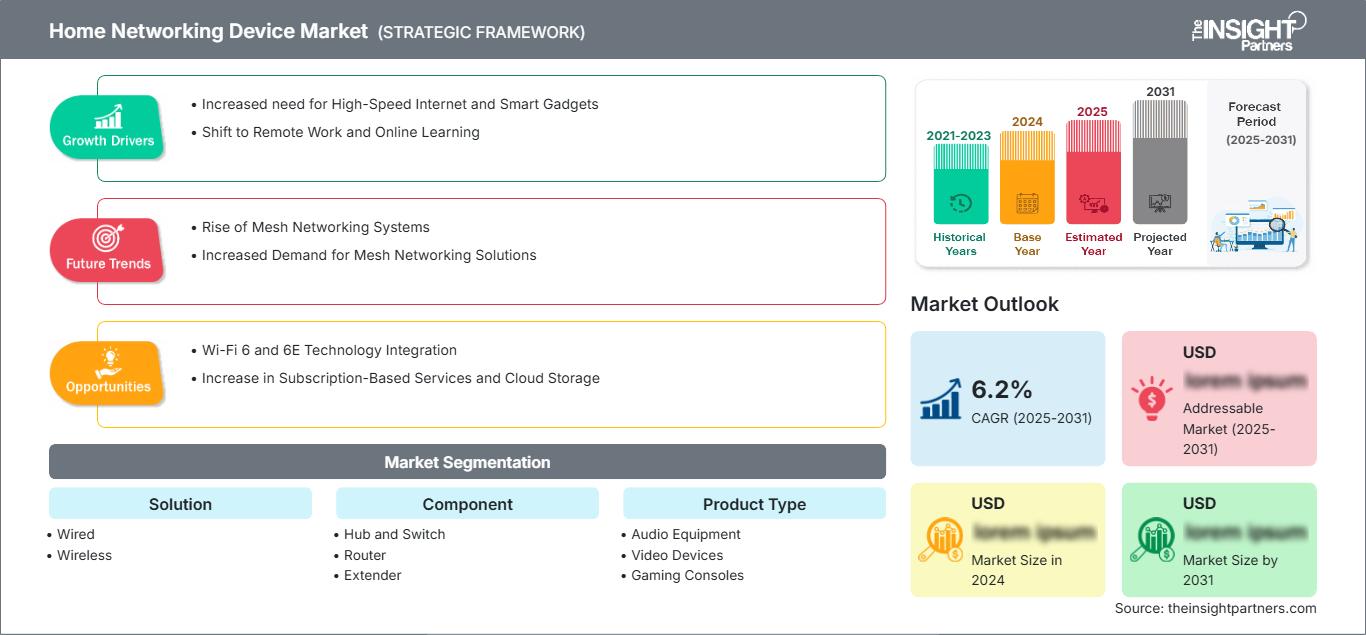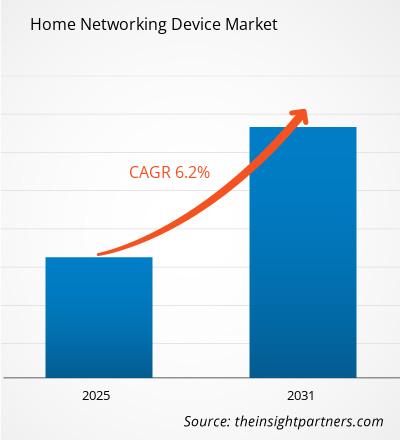Se espera que el mercado de dispositivos de redes domésticas alcance los 42 980 millones de dólares estadounidenses para 2031. Se prevé que registre una tasa de crecimiento anual compuesta (TCAC) del 4,8 % entre 2025 y 2031.
El informe está segmentado por solución (cableada, inalámbrica); componente (concentrador y conmutador, enrutador, extensor, adaptador, punto de acceso inalámbrico); tipo de producto (equipo de audio, dispositivos de video, consolas de videojuegos); usuario final (grandes empresas, pequeñas empresas, medianas empresas); sector vertical (telecomunicaciones, hogar inteligente, TI, otros). El análisis global se desglosa a nivel regional y por países principales. El informe ofrece el valor en USD para el análisis y los segmentos mencionados.
Propósito del Informe
El informe "Mercado de Dispositivos de Red Doméstica" de The Insight Partners busca describir el panorama actual y el crecimiento futuro, los principales factores impulsores, los desafíos y las oportunidades. Esto proporcionará información a diversas partes interesadas del negocio, como:
- Proveedores/fabricantes de tecnología: Para comprender la dinámica cambiante del mercado y conocer las oportunidades potenciales de crecimiento, lo que les permitirá tomar decisiones estratégicas informadas.
- Inversores: Realizar un análisis exhaustivo de tendencias respecto a la tasa de crecimiento del mercado, las proyecciones financieras del mercado y las oportunidades que existen en toda la cadena de valor.
- Órganos reguladores: Regular las políticas y las actividades policiales en el mercado con el objetivo de minimizar el abuso, preservar la confianza de los inversores y defender la integridad y estabilidad del mercado.
Solución para la segmentación del mercado de dispositivos de redes domésticas
- Con cable
- Inalámbrico
Componente
- Concentrador y conmutador
- Enrutador
- Extensor
- Adaptador
- Punto de acceso inalámbrico
Tipo de producto
- Equipo de audio
- Dispositivos de vídeo
- consolas de juegos
Usuario final
- Grandes empresas
- Pequeñas empresas
- Empresas medianas
Vertical de la industria
- Telecomunicación
- Casa inteligente
- ÉL
- Otros
Obtendrá personalización en cualquier informe, sin cargo, incluidas partes de este informe o análisis a nivel de país, paquete de datos de Excel, así como también grandes ofertas y descuentos para empresas emergentes y universidades.
Mercado de dispositivos de redes domésticas: Perspectivas estratégicas

-
Obtenga las principales tendencias clave del mercado de este informe.Esta muestra GRATUITA incluirá análisis de datos, desde tendencias del mercado hasta estimaciones y pronósticos.
Factores que impulsan el crecimiento del mercado de dispositivos de redes domésticas
- Mayor necesidad de internet de alta velocidad y dispositivos inteligentes: A medida que los dispositivos IoT (Internet de las Cosas), los servicios de streaming, el teletrabajo y los juegos en línea se vuelven más populares, los clientes necesitan una conexión a internet más rápida y fiable. Esto genera una demanda de dispositivos de red domésticos avanzados, como routers, extensores y sistemas de malla, que puedan ofrecer una cobertura y velocidad óptimas en áreas más extensas.
- Transición al teletrabajo y al aprendizaje en línea: La pandemia de COVID-19 ha acelerado la adopción del teletrabajo y la educación en línea, lo que requiere redes domésticas más robustas y de alto rendimiento. A medida que más personas teletrabajan y asisten a reuniones virtuales, aumentará la demanda de equipos de redes domésticas actualizados para satisfacer estas necesidades.
Tendencias futuras del mercado de dispositivos de redes domésticas
- Auge de los sistemas de redes en malla: Las soluciones de redes en malla están reemplazando a los routers tradicionales en muchos hogares, ya que ofrecen una cobertura Wi-Fi fluida en espacios amplios, incluso en varias paredes o plantas. Esta técnica es especialmente frecuente en hogares inteligentes, donde los dispositivos están dispersos en grandes áreas.
- Mayor demanda de soluciones de redes en malla: La demanda de soluciones de redes en malla está en aumento a medida que los consumidores buscan eliminar las zonas sin señal y mejorar la cobertura Wi-Fi en sus hogares. Los sistemas en malla constan de múltiples nodos que trabajan juntos para crear una red sin interrupciones, proporcionando una conectividad consistente en espacios más amplios. Esta tendencia es especialmente atractiva para hogares con múltiples dispositivos y usuarios, ya que mejora el rendimiento general de internet y la experiencia del usuario.
Oportunidades de mercado para dispositivos de redes domésticas
- Integración de las tecnologías Wi-Fi 6 y 6E: Ante la creciente demanda de velocidades más rápidas y más dispositivos conectados, la incorporación de las tecnologías Wi-Fi 6 y 6E en los equipos de red domésticos presenta un enorme potencial. Estas tecnologías ofrecen mayor ancho de banda, mayor eficiencia y menor congestión, lo que las hace perfectas para hogares con varios dispositivos y tráfico considerable.
- Aumento de los servicios de suscripción y el almacenamiento en la nube: La creciente dependencia de los servicios de entretenimiento por suscripción (p. ej., Netflix, Disney+) y del almacenamiento en la nube para datos personales crea nuevas perspectivas para los proveedores de redes domésticas. Los dispositivos que ofrecen un soporte sólido para estos servicios, como los diseñados para optimizar el streaming y la transferencia de archivos de gran tamaño, tienen una gran demanda.
Perspectivas regionales del mercado de dispositivos de redes domésticas
Los analistas de The Insight Partners han explicado detalladamente las tendencias y los factores regionales que influyen en el mercado de dispositivos de redes domésticas durante el período de pronóstico. Esta sección también analiza los segmentos y la geografía del mercado de dispositivos de redes domésticas en América del Norte, Europa, Asia Pacífico, Oriente Medio y África, y América del Sur y Central.
Alcance del informe de mercado de dispositivos de redes domésticas
| Atributo del informe | Detalles |
|---|---|
| Tamaño del mercado en 2024 | XX mil millones de dólares estadounidenses |
| Tamaño del mercado en 2031 | US$ 42.98 mil millones |
| CAGR global (2025-2031) | 4,8% |
| Datos históricos | 2021-2023 |
| Período de pronóstico | 2025-2031 |
| Segmentos cubiertos |
Por solución
|
| Regiones y países cubiertos |
América del norte
|
| Líderes del mercado y perfiles de empresas clave |
|
Densidad de actores del mercado de dispositivos de redes domésticas: comprensión de su impacto en la dinámica empresarial
El mercado de dispositivos de redes domésticas está creciendo rápidamente, impulsado por la creciente demanda de los usuarios finales debido a factores como la evolución de las preferencias de los consumidores, los avances tecnológicos y un mayor conocimiento de las ventajas del producto. A medida que aumenta la demanda, las empresas amplían su oferta, innovan para satisfacer las necesidades de los consumidores y aprovechan las tendencias emergentes, lo que impulsa aún más el crecimiento del mercado.

- Obtenga una descripción general de los principales actores clave del mercado de dispositivos de redes domésticas
Puntos clave de venta
- Cobertura integral: el informe cubre exhaustivamente el análisis de productos, servicios, tipos y usuarios finales del mercado de dispositivos de redes domésticas, proporcionando un panorama holístico.
- Análisis de expertos: el informe se compila con base en el conocimiento profundo de expertos y analistas de la industria.
- Información actualizada: El informe asegura relevancia comercial debido a su cobertura de información reciente y tendencias de datos.
- Opciones de personalización: este informe se puede personalizar para satisfacer los requisitos específicos del cliente y adaptarse adecuadamente a las estrategias comerciales.
Por lo tanto, el informe de investigación sobre el mercado de dispositivos de redes domésticas puede ayudar a descifrar y comprender el panorama de la industria y sus perspectivas de crecimiento. Si bien existen algunas preocupaciones válidas, las ventajas generales de este informe suelen superar las desventajas.
- Análisis histórico (2 años), año base, pronóstico (7 años) con CAGR
- Análisis PEST y FODA
- Tamaño del mercado, valor/volumen: global, regional y nacional
- Industria y panorama competitivo
- Conjunto de datos de Excel
Informes recientes
Testimonios
Razón para comprar
- Toma de decisiones informada
- Comprensión de la dinámica del mercado
- Análisis competitivo
- Información sobre clientes
- Pronósticos del mercado
- Mitigación de riesgos
- Planificación estratégica
- Justificación de la inversión
- Identificación de mercados emergentes
- Mejora de las estrategias de marketing
- Impulso de la eficiencia operativa
- Alineación con las tendencias regulatorias






















 Obtenga una muestra gratuita para - Mercado de dispositivos de redes domésticas
Obtenga una muestra gratuita para - Mercado de dispositivos de redes domésticas